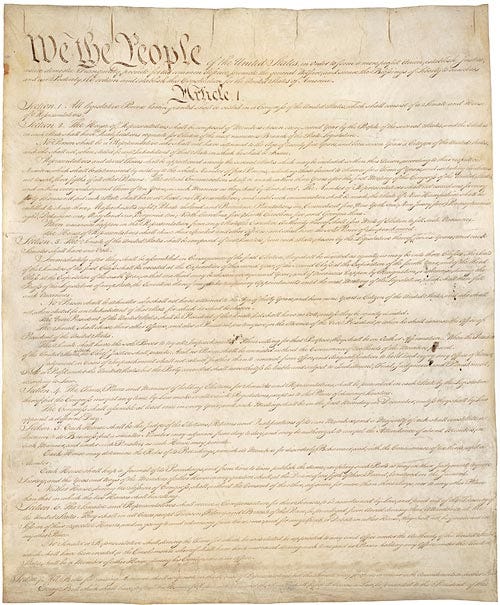Everything You Forgot to Remember About the US Constitution
Your Crash Course to America's Governing Document
How hard did you party for Constitution Day yesterday? Me too.
If you’re like most Americans, you likely missed the annual observance of Constitution Day on September 17th—the anniversary of the day in 1787 when delegates in Philadelphia signed the US Constitution, a genius and foundational document that still largely governs us today.
Cue the Alanis Morrissette music: isn’t it ironic that we revere the Constitution for its enormous impact over 238 years, yet most of us—yes, this is proven year after year—would flunk a basic pop-quiz on the thing? We assume it says things it doesn’t, forget what it actually does say, and even forget that it wasn’t our first attempt at a US federal government.
That ain’t right.
So, let’s fix that together with a quick crash course on one of the most influential governing documents in history.
1. Why They Constitution Exists in the First Place
The Constitutional Convention on 1787 was called to amend the Articles of Confederation, America’s first shot at self-government after the Revolution.
Most agreed the Articles weren’t working—but few wanted to admit publicly they needed to be scrapped entirely. As a result, the delegates met in secret under the pretense of only updating the Articles. Whoops. Instead, they produced a whole new system of government.
That secrecy raised the stakes: if they failed, there might not be a third chance for a federal government.
2. Who Was (and Wasn’t) in the Room—it wasn’t a big party
Only 55 delegates attended the Constitutional Convention at one time or another, but at no time did all 55 men attend at the same time.
Only 11 states were present at any given time. Rhode Island boycotted the whole thing. New Hampshire showed up two months late. Most of New York’s delegation walked out, leaving only a young Alexander Hamilton, powerless to vote on behalf of the Empire State. This is why Washington later wrote that the Constitution was signed by “11 states and Colonel Hamilton.”
Who wasn’t there? No Thomas Jefferson (he was in France). No John Adams (in Britain), either. Neither were Samuel Adams, John Hancock (of autograph fame), and Patrick Henry, who declined to attend because he said he “smelt a rat in Philadelphia.”
Madison was at the Convention, furiously taking notes. Ben Franklin was the oldest delegate at 81. The youngest? Twenty-six year old Jonathan Dayton of New Jersey. Wonder what happened to him?
George Washington presided, but spoke very little. Delegates found it a little awkward that they were debating how to limit or empower the president because everyone and their momma knew that Washington was going to serve as the first Commander-in-Chief.
3. The Myth of “Demigods” vs. the Messy Reality
Thomas Jefferson famously called the delegates an “assembly of demigods.” The quote makes it sound like they effortlessly drafted a perfect plan provided to them by the Heavens. In truth, many big-ticket items were decided by razor-thin votes and only after constant reversals.
Example: the president’s term. At first, delegates agreed that the president should serve a single 7-year term, with Congress choosing who would serve. Later debates whittled that down to 4 years, with POTUS being elected indirectly via the Electoral College.
Delegates voted several times to try to Goldilocks their way to the right term length for Senators. Five years? Too cold. Nine years? Too hot. What about 6 years, but with only 1/3rd of the Senators up reelection every two years? Just right.
One thing that was not debated much at all? The Constitution should have a way to be amended by future generations. That baby passed unanimously.
In the end, only 39 men signed the document. Three delegates who attended refused to sign it because they thought it wasn’t good enough.
4. What’s Not in the Constitution
The Bill of Rights wasn’t part of the original document—it was added four years later as the first 10 Amendments to the Constitution. (Told you they expected it to be amended.)
No mention of political parties. The framers feared them, and yet parties sprouted instantly, led by many of the same dudes in the room.
Not a single mention of democracy or slavery (the latter was papered over with compromises like the Three-Fifths Clause and other veiled language).
Though Constitution requires a Supreme Court, it never says how many justices should sent on the bench. Congress passed a law providing for six justices, which obviously caused a few problems.
Also in Courts land, the Constitution does not give the Supreme Court power to declare laws unconstitutional, an authority known as “judicial review.” The Supreme Court gave itself that power in 1803.
Executive privilege is not mentioned in the Constitution, nor is the filibuster.
5. Numbers and Nerdy Details
The Constitution is only 4,543 words (including all of the signatures), making it the shortest national constitution in use today (and far shorter than most Terms of Service agreements you never read but click ‘accept’ on).
The parchment famously misspells “Pensylvania” above the signatures. Can the Founders get a spell check?
Only one amendment has ever been repealed: Prohibition (the 18th), undone by the 21st.
Which leads to a fun fact? Did you know that the only way to repeal an amendment is by passing an additional amendment? This means that we will never have fewer than 27 amendments ‘til the end of time.
Six men signed both the US Constitution and the Declaration of Independence. Who are they? And no, George Washington isn’t one of them.
The Takeaway
The Constitution is remarkable not because it’s perfect, but because it’s flexible enough to keep adapting. Constitution Day isn’t about worshipping the past—it’s about remembering that the rules of democracy are meant to be argued over, tested, and improved.




Loved this post!!